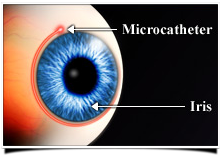
Traditional glaucoma surgeries (trabeculectomy or shunt surgery) require the creation of a full-thicknes hole (or fistula) through the wall of the eye (sclera). This allows fluid to flow from the inside of the front of the eye (anterior chamber) through the scleral hole to a bleb (cyst, or blister-like elevation of the conjunctiva). From here the fluid somehow finds its way back into the venous system. These surgeries are called “penetrating.” Canaloplasty, on the other hand, is a non-penetrating (or “minimally invasive”) surgery because only a partial thickness flap is created in the sclera. This flap is then sewn back in place after Schlemm’s canal is opened so there is no fistual created between the inside and outside of the eye. Instead, fluid in the eye drains out through the (newly opened) natural drainage system of the eye.
Canaloplasty FAQ Video Playlist
View all Canaloplasty Treatment FAQ videos in one playlist
Need Help with Your Glaucoma?
Learn more about this blinding disease. Know your treatment options. Talk to a board-certified Ophthalmologist who is an expert in the treatment of glaucoma and cataract.


